2023.08.03.74
Files > Volume 8 > Vol 8 No 3 2023
Effect of Freezing On Some Morphometric Features of Planiliza Abu ( Hekel,1843)
*1 Iraq Natural History Museum and Research Center, University of Baghdad
. Corresponding author. [email protected]
Available from: http://dx.doi.org/10.21931/RB/2023.08.03.74
ABSTRACT
The present study attempts to determine the effect of freezing for different periods on preserved bodies of fish in the laboratory to keep for the research and diagnosis of taxonomic studies and not for consumption. It also endeavors to identify the effect of freezing on some morphometric features of the preserved bodies of fishes. Planiliza abu fish were used to conduct the present study. Fish were frozen by regular freezing in the home refrigerator freezer with temperatures reaching four degrees centigrade below zero. Freezing time is distributed over four months; biometric measurements of frozen fish have been taken in these periods represented by body total length, Standard length, and Head length in centimeters using a ruler vernier caliper in addition to body weight in grams by using a scale. Statistical data analysis for this experiment has been conducted to investigate the resulting facts of freezing periods and the effect of differences in freezing periods on these biometric measurements using Duncan's new multiple range test and Levene's test. Results showed no apparent significant differences related to the size in total length and standard length and weight, While measuring head length showed important characteristics of frozen fish, especially in the first and third month of the experiment. Most of the sources that deal with such research patterns are concerned with the freezing of fish intended for food and human consumption, and few of these studies are concerned with research freezing, such as preserving frozen fish specimens for analysis, even for some time. Attention to the importance of freezing for research studies related to fish because of the susceptibility of its meat to rapid deterioration, and therefore, may give wrong diagnostic results if the survey is between species from the same family or a diagnostic and taxonomic study between many species belonging to different families.
Keywords: Body measurements, Coastal fish, External appearance, Ice crystals, Preservation.
INTRODUCTION
Fish bodies are perishable after being collected and caught, so these bodies start to decompose and scales become soft, and their chemical and physical properties change during Preservation and non-preservation; for this reason, human resorted for an extended period to freezing the bodies of fishes which are characteristics high level of moisture which comes to about %60 out of fish weight and thus the process of freezing will be faster and simpler by turning the water of fish bodies into ice crystals inside their bodies 1,2.
During the freezing, chemical and physical changes on the frozen bodies of fish appear as shown in 3,4,5. These changes may be excellent or unacceptable if these fish are ready to eat. Freezing with all its types, Domestic, Commercial and laboratory, does not affect the biological value of the fabric texture of fish. Quite to the contrary, freezing may exterminate some pathological causes that activate in low temperatures even after fish mortality, as confirmed in 6, 4. Points out that many frozen fish specimens have no evident change in the muscle tissue and different element concentrations in the muscle tissue of the fishes. Accordingly, This is deemed one of the most important reasons that make freezing the best method of preserving the quality of fish fleshes and muscles, as freezing helps to improve and maintain the nutritional value of fish because the elements and components of fish bodies have not changed. Nevertheless, this process is not optional for maintaining fish study specimens.
The main disadvantages of the freezing process include combustion by freezing, Drying specimens, Textures may be altered, Muscular tissue changes, and putrefaction 7. Besides, It may cause expansion and contraction in fish bodies due to the location of ice crystals that distribute in body texture 8; for this reason, new freezing methods have been found by using freezing and cooling solutions for maintaining the fish texture 9. The current study aims to use the freezing process to preserve fish for research purposes for different diagnostic and taxonomical studies.
MATERIALS AND METHODS
Twenty-five Planiliza abu collected from Baghdad were used to conduct the present study. Fish were frozen by regular freezing in the home refrigerator freezer with temperatures reaching four degrees centigrade below zero. Freezing time is distributed in four months, starting from 25 February, 25 March, 29 April, and ending on 27 May 2021. In these periods, biometric measurements of frozen fish have been taken by body total length, Standard length, Head length in centimeters, and body weight in grams.
The statistical analysis of data for this experiment has been carried out to investigate the resulting facts of freezing periods as well as the effect of the difference in freezing periods on these biometric measurements that have been taken from fish bodies; descriptive analysis has been conducted for all data to identify the statistical differences among the four periods of freezing for each biometric measurements, Duncan's new multiple range test has been used as one of posttest to determine the differences between the averages which show statistical differences. Ultimately, the Person correlation coefficient has been used to determine if there is a correlation between the given biometric measurements in the current study. Also, Levene's test has been used to identify the existing homogeneity of variances between given biometric measurements in the present study.
RESULTS
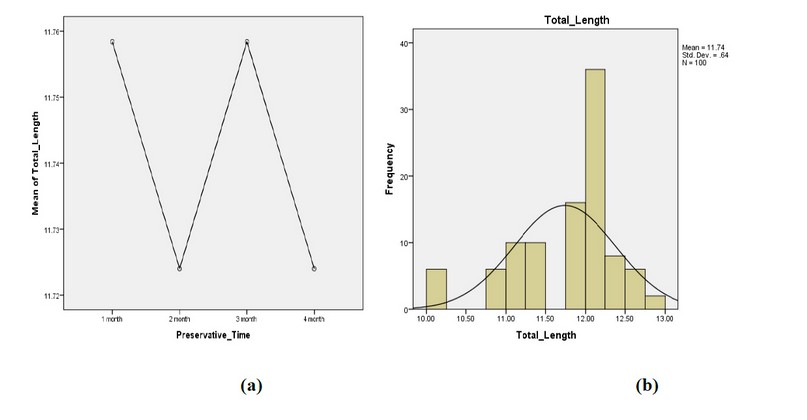
Figure 1 Total length of frozen fish during the experiment period. (a) According to the statistical analysis, (b) Frequency analysis for total length.
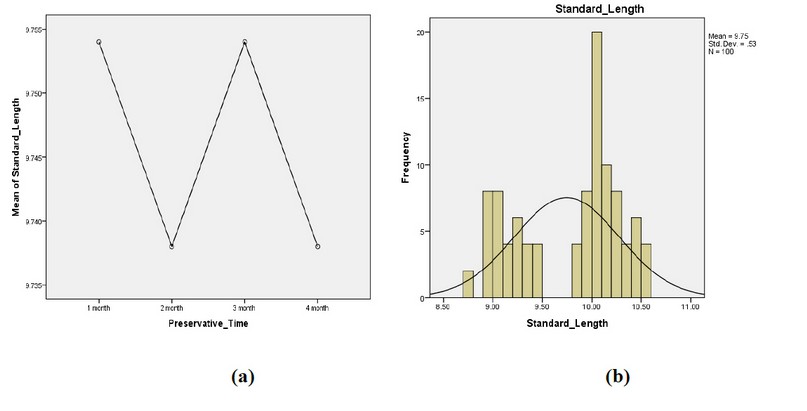
Figure 2. Standard length of frozen fish during the experiment period. (a) According to the statistical analysis, (b) Frequency analysis for total length.
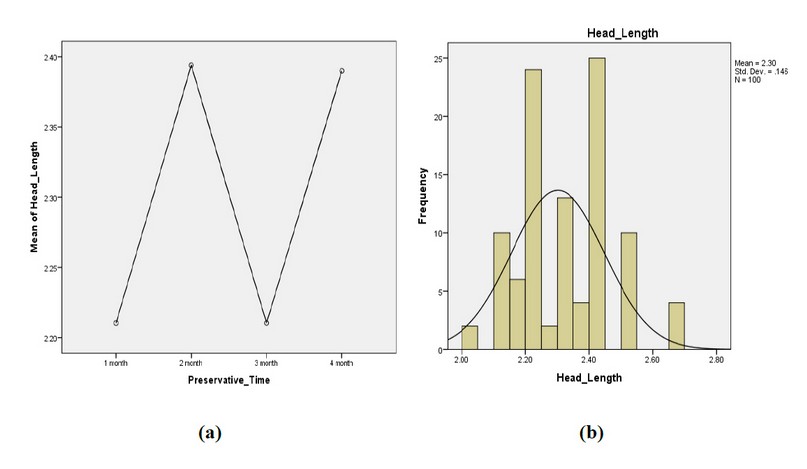
Figure 3. Head length of frozen fish during the experiment period. (a) According to the statistical analysis; (b) Frequency analysis for total length.
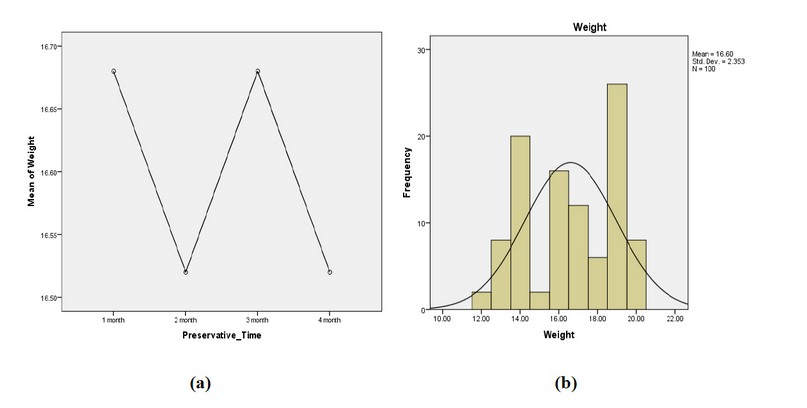
Figure 4. Weight of frozen fish during the experiment period. (a) According to the statistical analysis, (b) Frequency analysis for total length.
Table 1 illustrates some primary biometric measurements of Planiliza Abu before starting the experiment. The averages of some preliminary biometric measurements of fish bodies were 11.94cm average body total length, 9.84cm average standard length, 2.40cm average head length and 21.2gm average body weight.
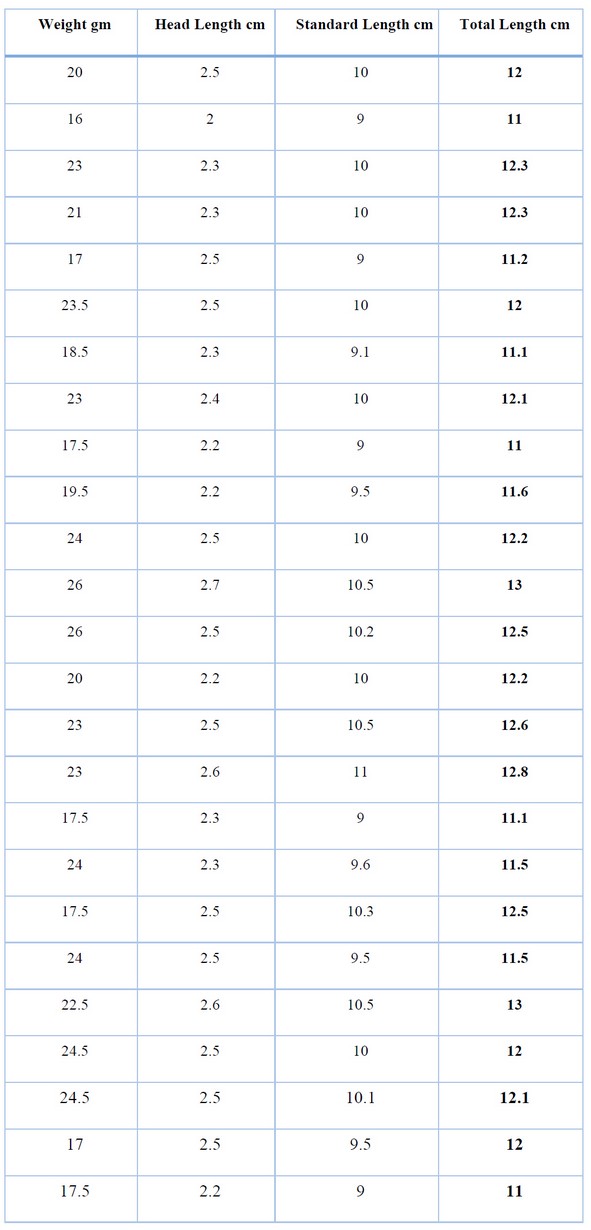
Table 1 Some Primary Biometric Measurements of Planiliza abu
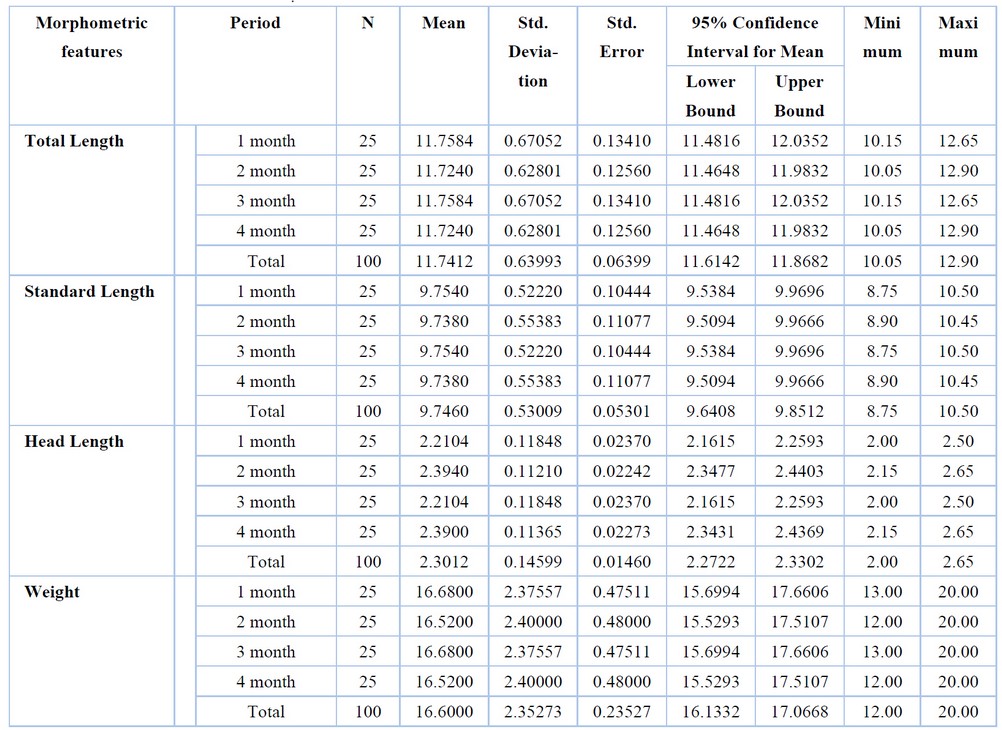
Table 2. The descriptive statistics for the whole biometric measurements along the periods of freezing taken in the current study
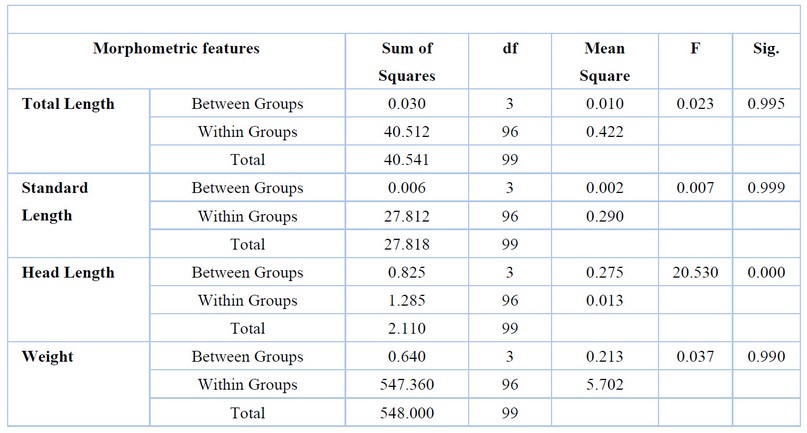
Table 3. Anova test for the whole biometric measurements along the periods of freezing.
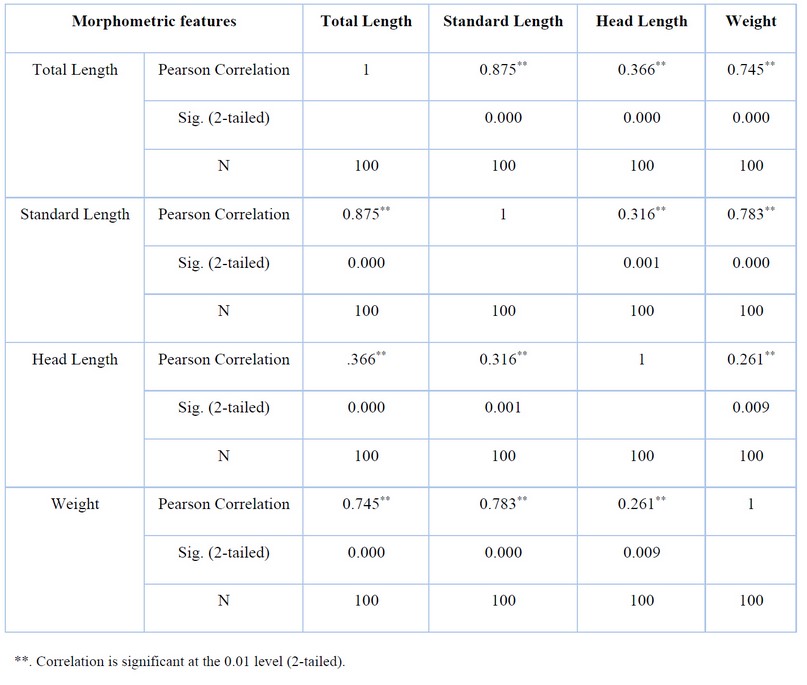
Table 4. Correlation coefficient between the given biometric measurements.
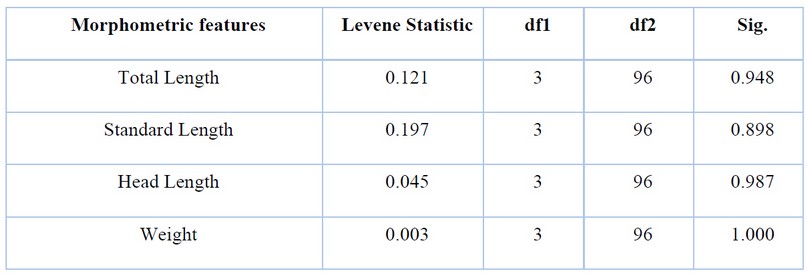
Table 5. Existing data are homogeneous according to Levene's test.
DISCUSSION
Table 1 illustrates some primary biometric measurements of Planiliza Abu before starting the experiment. The averages of some primary biometric measurements of fish bodies were 11.94cm average body total length, 9.84cm average standard length, 2.40cm average head length and 21.2gm average body weight. Table 2 illustrates the descriptive statistics for the whole biometric measurements along the periods of freezing taken in the current study four months after conducting the ANOVA test. There are no significant differences for averages of total length, Standard length, or weight where there are significant differences between averages of head length during periods of freezing, as shown in Table 3.
Table 4 illustrates the correlation coefficient between the given biometric measurements in the current study, represented by the total length, Standard length, Head length and weight of frozen fish. The table gives a positive result on the correlation among all these features as shown in the above table; thus, For confirming homogeneity, The analyses have been done according to Leven's test, as shown in Table 5, where the results have appeared positive for the homogeneity among the given features.
It has been found that there are no tangible sensory changes in the external appearance of frozen fish along the differing periods of freezing, and fish bodies preserved their size and shape as well as their smell still preserved associated with a small quantity of dryness in the eyes. This result agrees with what (10) has stated. There are no apparent significant differences between the averages of the total length and standard length of frozen specimens along the period of freezing, as shown in Figures (1) and Figure (2).
The result is typically consistent with what both(11,12) have said, as there have been no changes in the freezing heights in different periods between the two studies with differing species under study. It takes note of the fact that all four internationally known methods, Which are freezing, Preservation in salt, and Preservation with chemicals represented by diluted formalin and ethyl alcohol, may affect some of the biometrics of fish specimens, and they may cause shrinkage and contraction, especially of different lengths(12).
Some researchers argue that there is a loss in the length of the frozen specimens, as these substances may cause contractions and shrinkage as illustrated by(13,14,15,16,17) due to the freezing mechanism and fish preparation method before freezing, for instance, in the case of disposal of a large amount of water before carrying out fish freezing and Preservation. Therefore, there is no loss in the total and standard length of fish after freezing fish for four months because the water-reducing agent has played a vital role in reducing the occurrence of ice crystals, which negatively affect the body texture and tissues. Accordingly, they may cause shrinkage contraction. Other researchers(18,19,20) Point out a slight change and increase in frozen fish lengths. It has been observed that the occurring changes in the head length show a high response of shrinkage and contraction during long periods of freezing. A precise significant degree was recorded during the experiment, and these changes were observed during the first and the third months, as shown in Figure (3). This variance in the head length of specimens gives an impression of occurring shrinkage and contraction in the head where the variance in length and shrinkage and contraction are vital after the sixth and seventh weeks of freezing, as shown by (21), Who points out that there is an increase in total length of fish after freezing as well as there is a variance in total length after the seventh week of freezing. Accordingly, This study aligns with what (21) said concerning the head length since there is a significant shrinkage in the depth of frozen fish heads.
The weight of frozen fish specimens may be affected by the amount of moisture between the body's texture tissues and the amount of water in the form of frozen ice crystals in these tissues. So, the existence of these ice crystals is regarded to be the cause of reducing weight after freezing, as stated by (22). In the current study, There is no change in the averages of weights of frozen specimens, as illustrated in Figure (4), and there are no significant differences in the weight of frozen specimens. Thus, these results differ from (23). It is possible due to the differences in freezing periods between the two studies. ( 22) Pointed out that the increase of loss in the frozen fish weight is directly proportional to the period of freezing.
Knowing that reducing the amount of moisture in the specimens to the minimum before freezing may decrease the formation of ice crystals in the bodies of frozen fish and, therefore, the resulting loss would be reduced during the long period of freezing (22) is in line with the outcome of the current study where the amount of moisture and water in the bodies of fish have been reduced before freezing which reduces the loss of weight after four months preservation.
CONCLUSIONS
Freezing is considered one of the best methods of preserving fish specimens under study. Besides, it is a primary means for preserving fish in particular and other aquatic biology in general because of the hypothermia of fish bodies and cooling them to make them fit for human consumption for long periods, which is associated with freezing food. As for laboratory freezing, It differs in the current study since there is no need for the nutritional value of given specimens, especially in the cases of diagnoses and taxonomic studies.
The current study revealed no tangible sensory changes in the external appearance of frozen fish along the differing periods of freezing, and fish bodies preserved their size and shape, and their smell was still associated with a small quantity of dryness in the eyes.
Acknowledgments: Many thanks to Dr. Ali Arif from the College of Languages, Department of English Language, for reviewing and evaluating the English language of this manuscript.
REFERENCES
1. Clucas, I.J. and Ward, A.R. Preservation: Processing and Quality Chathan Maritime.1996. 443 p.
2. Nowsad, AKM, A. Participatory Training of Trainers: A New Approach Applied in Fish Processing. Bangladesh Fisheries Research Forum. 2007. 329 p.
3. Ke Liang B. Chang , Jejia Chang , Chyuan-Yuan Shiau , and Bonnie S. Pan. Biochemical, Microbiological, and Sensory Changes of Sea Bass (Lateolabrax japonicus) under Partial Freezing and Refrigerated Storage, Department of Marine Food Science, National Taiwan Ocean University, Keelung 202, Taiwan, Republic of China, J. Agric. Food Chem. 1998. 46 (2), pp 682–686.
4. Arannilewa, S.O. Salawu, A.A. Sorungbe and B.B. Ola-Salawu. Effect of frozen period on the chemical, microbiological and sensory quality of frozen tilapia fish (Sarotherodun galiaenus). African Journal of Biotechnology. 2005. Vol. 4 (8), pp. 852-855.
5. Keith L Bosley, Sam C Wainright. Effects of preservatives and acidification on the stable isotope ratios (15N:14N, 13C:12C) of two species of marine animals. Canadian Journal of Fisheries and Aquatic Sciences. 2011. 56(11): 2181-2185, 10.1139/f 99-153.
6. Thomas L. Deardorff and Richard Thorm. Commercial blast freezing of third stage Anisakis simplex larvae encapsulated in Salmon and Rockfish. J.Parasit.1988. 74(4): 600-603.
7. Kropf DH, Bowers JA. Meat and meat products. In Bowers (eds.).Food Theory and applications. New York: Macmillan Publishing Company. 1992.pp.22-29.
8. Kono, S., Kon, M., Araki, T., & Sagara, Y. Effects of relationships among freezing rate: ice crystal size and color on surface color of frozen salmon fillet. Journal of Food Engineering. 2017. 214, 158-165. http://dx.doi.org/10.1016/j.jfoodeng.2017.06.023.
9. Espinoza Rodezno, L. A., Sundararajan, S., Solval, K. M., Chotiko, A., Li, J., Zhang, J., Alfaro, L., Bankston, J. D., & Sathivel, S. Rodezno, L. A. E., Sundararajan, S., Solval, K. M., Chotiko, A., Li, J., Zhang, J., & Sathivel, S. Cryogenic and air blast freezing techniques and their effect on the quality of catfish fillets. Lebensmittel-Wissenschaft + Technologie. 2013. 54(2), 377-382. http://dx.doi.org/10.1016/j.lwt.2013.07.005.
10. J. Syväranta , A. Martino, D. Kopp, R. Céréghino and F. Santoul. Freezing and chemical preservatives alter the stable isotope values of carbon and nitrogen of the Asiatic clam (Corbicula fluminea), Hydrobiologia. 2010. 658, Number 1, pp. 383-388.
11. Stigurgisladottir, S.; Sigurdardottir, M. S.; Torrissen, O.; Vallet, J. L.; Hafsteinssen, H. Effects of different salting processes on the microstructure :the texture and yield of Atlantic salmon (Salmo salar) fillets. Food Res. Int. 2000. 33, pp. 847–855.
12. P. O. Ajah1 and F. K. E. Nunoo. The effects of four preservation methods on length, weight and condition factor of the clupeid Sardinella aurita Val. 1847, J. Appl. Ichthyol. 2003.19, 1–3.7
13. Lux FE. Length shrinkage of yellowtail flounder, Limanda ferruginea between live and land condition. Transaction of the American Fisheries Society. 1960. 89: 373-374.
14. Parker RP. Effects of formalin on length and weight of fishes. Journal of the Fisheries Board of Canada. 1963. 20: pp.1441-1455.
15. Stobo WT. Effects of formalin on the length and weight of yellow perch, Perca flavescens. Transaction of the American Fisheries Society. 1972. 101: 362-364.
16. Engel S. Effects of formalin and freezing on length, weight and condition factor of cisco, Coregonus artedi and yellow perch, Perca flavescens. Transaction of the American Fisheries Society. 1974. 1: 136-138.
17. Sayers RE. Effects of freezing in and out of water on length and weight of Lake Michigan Bloaters, Coregonus hoyi. North American Journal of Fisheries Management. 1987. 7: 299-301.
18. Billy AJ. The effect of formalin and isopropyl alcohol on length and weight measurements of Sarotherodon mossambicus Trewaves. Journal of Fish Biology. 1982. 21:107-112.
19. Al-Hassan LAJ & NA Shawafi. The effect of preservatives and freezing on the morphological characters of Rastrelliger kanagurta (Pisces: Scombridae). Journal of Animal Morphology and Physiology. 1997. 44: 17-20.
20. Al-Hassan LAJ, JA Bujawari & OA El-Silini. The effect of some preservatives and freezing on certain body dimensions of two species of the family Mullidae collected from Benghazi waters, Libya. Acta Ichthyologica et Piscatoria. 2000. 30: 127-136.
21. Laith A. Jawad. The effect of formalin, alcohol and freezing on some body proportions of Alepes djeddaba (Pisces: Carangidae) collected from the Red Sea coast of Yemen. Revista de Biología Marina y Oceanografía. 2003. 38 (2): 77 – 80.
22. Boonsumrej, S., Chaiwanichsiri, S., Tantratian, S., Suzuki, T., & Takai, R. Effects of freezing and thawing on the quality changes of tiger shrimp (Penaeus monodon) frozen by air-blast and cryogenic freezing. Journal of Food Engineering. 2007. 80(1), 292-299. http://dx.doi. org/10.1016/j.jfoodeng.2006.04.059.
23. Anese, M., Manzocco, L., Panozzo, A., Beraldo, P., Foschia, M., & Nicoli, M. C. Effect of radiofrequency assisted freezing on meat microstructure and quality. Food Research International. 2012. 46(1), 50-54. http://dx.doi.org/10.1016/j.foodres.2011.11.025
Received: 25 June 2023/ Accepted: 26 August 2023 / Published:15 September 2023
Citation: Ghazwan M I. Effect of Freezing On Some Morphometric Features of Planiliza Abu ( Hekel,1843). Revis Bionatura 2023;8 (3) 74. http://dx.doi.org/10.21931/RB/2023.08.03.74
